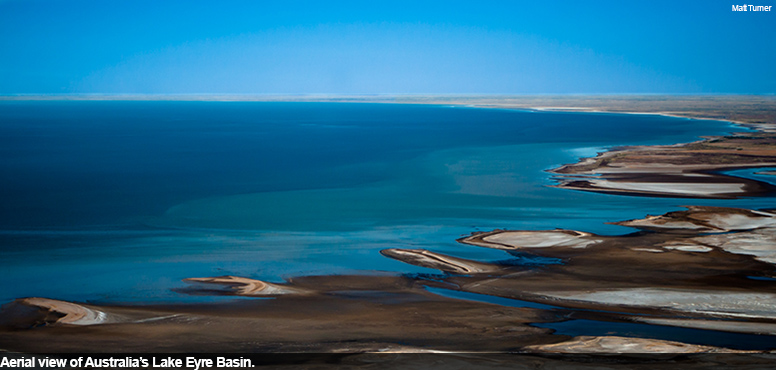Protecting the Life Blood of Australia's Outback
Covering one-sixth of Australia, the Lake Eyre Basin is the life blood of the continent's Outback. It acts as an enormous internal drainage system for the continent and is fed by some of the world's last unregulated river systems.
Cooper Creek and the Diamantina and Georgina rivers make up what is known as Channel Country, flowing inland to fill Lake Eyre in one of the planet's most spectacular natural phenomena.

The Lake Eyre Basin is etched into the folklore of the Outback. It is where the famous Australian poet Banjo Paterson wrote in 1889 that the title character in “Clancy of the Overflow” had gone “a-droving”:
And the bush hath friends to meet him, and their kindly voices greet him In the murmur of the breezes and the river on its bars, and he sees the vision splendid of the sunlit plains extended, and at night the wond'rous glory of the everlasting stars.Banjo Paterson,"Clancy of the Overflow"
After heavy rainfall, the Channel Country's rivers flood across hundreds of miles, spreading water from the Outback's tropical north to its arid center. These rivers are the lifeblood of Australia's grazing industry and the region's Indigenous people. The basin is also critical for wildlife, particularly water birds that migrate from around the world to breed and feed when the waters flow.
Because the Channel Country's rivers are so important, the Queensland Parliament passed the Wild Rivers Act in 2005. The act resulted from efforts by a diverse group of grazers, Aboriginal landowners, scientists, and environmentalists to pressure the Queensland Government to protect the state's healthy river systems. The act safe guards the region's rivers from new large-scale development projects, such as mining, large dams, and irrigated agriculture.
But the Queensland Government elected last year is considering rewriting the act to allow irrigators and miners access to the Lake Eyre Basin. This could be disastrous for the rivers' natural function, for wildlife, and for Queensland's multimillion-dollar grazing industry.
"The Lake Eyre Basin must be protected," said Barry Traill, who directs Pew's Australia program. "Any type of irrigation and mining would cause serious and permanent damage to this unique and essential region.”
Indigenous people want permanent protection from mining and irrigation for the rivers that fill Lake Eyre and the floodplains of Channel CountryScott Gorringe, Traditional Owner
The basin has already experienced the devastation that mining accidents can cause. In 2009, a huge spill from the Lady Annie copper mine near Mount Isa released highly toxic waste into Channel Country rivers. Weakening the Wild Rivers Act would put more of the basin at risk of a similar disaster.
The threat of mining and irrigation has caused a diverse group consisting of grazers from throughout the basin, Traditional Owners, tourism operators, water scientists, and policy experts to reach an agreement calling for a special Act of Parliament to preserve the Wild Rivers Act.
“There has been more than a decade of consultation about the future of the Lake Eyre Basin,” said Scott Gorringe, a Traditional Owner from the Mithika people on Cooper's Creek. “Indigenous people want permanent protection from mining and irrigation for the rivers that fill Lake Eyre and the floodplains of Channel Country.”











